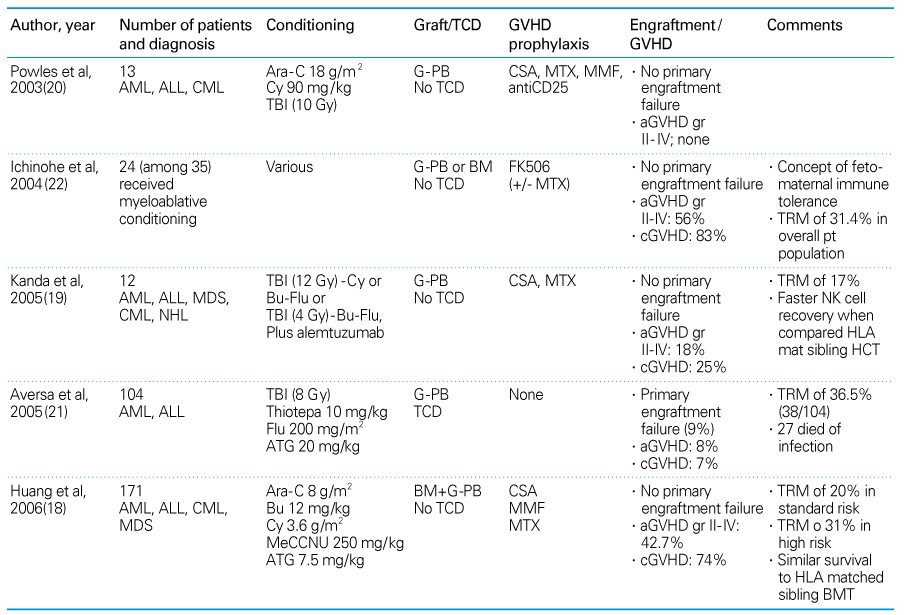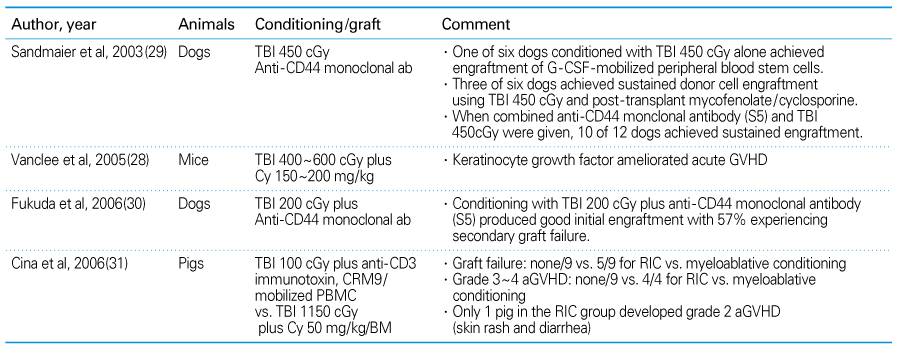1. Jacobson LO, Marks EK, Robson MJ, Gaston EO, Zirke RE. Effect of spleen protection on mortality following X- irradiation. J Laboratory Clin Med 1949;34:1538-1543.
2. Lorenz E, Uphoff D, Reid TR, Shelton E. Modification of irradiation injury in mice and guinea pigs by bone marrow injections. J Natl Cancer Inst 1951;12:197-201.
3. Thomas ED, Lochte HL Jr, Lu WC, Ferrebee JW. Intra-venous infusion of bone marrow in patients receiving radiation and chemotherapy. N Engl J Med 1957;257:491-496.
4. Bortin MM. A compendium of reported human bone marrow transplants. Transplantation 1970;9:571-587.
5. Epstein RB, Storb R, Ragde H, Thomas ED. Cytotoxic typing antisera for marrow grafting in littermate dogs. Transplantation 1968;6:45-58.
6. Storb R, Rudolph RH, Thomas ED. Marrow grafts between canine siblings matched by serotyping and mixed leukocyte culture. J Clin Invest 1971;50:1272-1275.
7. Buckner CD, Epstein RB, Rudolph RH, Clift RA, Storb R, Thomas ED. Allogeneic marrow engraftment following whole body irradiation in a patient with leukemia. Blood 1970;35:741-750.
8. Thomas ED, Storb R, Fefer A, Slichter SJ, Bryant JI, Buckner CD, Neiman PE, Clift RA, Funk DD, Lerner KE. Aplastic anaemia treated by marrow transplantation. Lancet 1972;1:284-289.
9. Thomas ED, Buckner CD, Banaji M, Clift RA, Fefer A, Flournoy N, Goodell BW, Hickman RO, Lerner KG, Neiman PE, Sale GE, Sanders JE, Singer J, Stevens M, Storb R, Weiden PL. One hundred patients with acute leukemia treated by chemotherapy, total body irradiation, and allogeneic marrow transplantation. Blood 1972;49:511-533.
10. Graw RG Jr, Santos GW. Bone marrow transplantation in patients with leukemia. Incidence and severity of graft-versushost disease in successful HL-A-matched transplants. Transplantation 1971;11:197-199.
11. Martin PJ. In: Blume KG, Forman SJ, Appelbaum FR, editor. Overview of hematopoietic cell transplantation immunology. Thomas' Hematopoietic Cell Transplantation 2004;3rd ed. Blackwell Publishing. 16-30.
12. Koh LP, Rizzieri DA, Chao NJ. Allogeneic hematopoietic stem cell transplant using mismatched/haploidentical donors. Biol Blood Marrow Transplant 2007;13:1249-1267.
13. Powles RL, Morgenstern GR, Kay HE, McElwain TJ, Clink HM, Dady PJ, Barrett A, Jameson B, Depledge MH, Watson JG, Sloane J, Leigh M, Lumley H, Hedley D, Lawler SD, Filshie J, Robinson B. Mismatched family donors for bone-marrow transplantation as treatment for acute leukaemia. Lancet 1983;1:612-615.
14. Beatty PG, Clift RA, Mickelson EM, Nisperos BB, Flournoy N, Martin PJ, Sanders JE, Stewart P, Buckner CD, Storb R, et al. Marrow transplantation from related donors other than HLAidentical siblings. N Engl J Med 1985;313:765-771.
15. Henslee-Downey PJ, Abhyankar SH, Parrish RS, Pati AR, Godder KT, Neglia WJ, Goon-Johnson KS, Geier SS, Lee CG, Gee AP. Use of partially mismatched related donors extends access to allogeneic marrow transplant. Blood 1997;89:3864-3872.
16. Lacerda JF, Martins C, Carmo JA, Lourenco F, Juncal C, Rodrigues A, Vilalobos I, Moura MC, Ligeiro D, Martinho A, Lacerda JM. Haploidentical stem cell transplantation with purified CD34 cells after a chemotherapy-alone conditioning regimen. Biol Blood Marrow Transplant 2003;9:633-642.
17. Lu DP, Dong L, Wu T, Huang XJ, Zhang MJ, Han W, Chen H, Liu DH, Gao ZY, Chen YH, Xu LP, Zhang YC, Ren HY, Li D, Liu KY. Conditioning including antithymocyte globulin followed by unmanipulated HLA-mismatched/haploidentical blood and marrow transplantation can achieve comparable outcomes with HLA -identical sibling transplantation. Blood 2006;107:3065-3073.
18. Huang XJ, Liu DH, Liu KY, Xu LP, Chen H, Han W, Chen YH, Wang JZ, Gao ZY, Zhang YC, Jiang Q, Shi HX, Lu DP. Haploidentical hematopoietic stem cell transplantation without in vitro T-cell depletion for the treatment of hematological malignancies. Bone Marrow Transplant 2006;38:291-297.
19. Kanda Y, Oshima K, Asano-Mori Y, Kandabashi K, Nakagawa M, Sakata-Yanagimoto M, Izutsu K, Hangaishi A, Tsujino S, Ogawa S, Motokura T, Chiba S, Hirai H. In vivo alemtuzumab enables haploidentical human leukocyte antigen-mismatched hematopoietic stem-cell transplantation without ex vivo graft manipulation. Transplantation 2005;79:1351-1357.
20. Chen HR, Ji SQ, Wang HX, Yan HM, Zhu L, Liu J, Xue M, Xun CQ. Humanized anti-CD25 monoclonal antibody for prophylaxis of graft-vs-host disease (GVHD) in haploidentical bone marrow transplantation without ex vivo T-cell depletion. Exp Hematol 2003;31:1019-1025.
21. Aversa F, Terenzi A, Tabilio A, Falzetti F, Carotti A, Ballanti S, Felicini R, Falcinelli F, Velardi A, Ruggeri L, Aloisi T, Saab JP, Santucci A, Perruccio K, Martelli MP, Mecucci C, Reisner Y, Martelli MF. Full haplotype-mismatched hematopoietic stem-cell transplantation: a phase II study in patients with acute leukemia at high risk of relapse. J Clin Oncol 2005;23:3447-3454.
22. Ichinohe T, Uchiyama T, Shimazaki C, Matsuo K, Tamaki S, Hino M, Watanabe A, Hamaguchi M, Adachi S, Gondo H, Uoshima N, Yoshihara T, Hatanaka K, Fujii H, Kawa K, Kawanishi K, Oka K, Kimura H, Itoh M, Inukai T, Maruya E, Saji H, Kodera Y. Feasibility of HLA-haploidentical hematopoietic stem cell transplantation between noninherited maternal antigen (NIMA)-mismatched family members linked with long-term fetomaternal microchimerism. Blood 2004;104:3821-3828.
23. Storb R, Yu C, Wagner JL, Deeg HJ, Nash RA, Kiem HP, Leisenring W, Shulman H. Stable mixed hematopoietic chimerism in DLA-identical littermate dogs given sublethal total body irradiation before and pharmacological immunosuppression after marrow transplantation. Blood 1997;89:3048-3054.
24. McSweeney PA, Niederwieser D, Shizuru JA, Sandmaier BM, Molina AJ, Maloney DG, Chauncey TR, Gooley TA, Hegenbart U, Nash RA, Radich J, Wagner JL, Minor S, Appelbaum FR, Bensinger WI, Bryant E, Flowers ME, Georges GE, Grumet FC, Kiem HP, Torok-Storb B, Yu C, Blume KG, Storb RF. Hematopoietic cell transplantation in older patients with hematologic malignancies: replacing high-dose cytotoxic therapy with graft-versus-tumor effects. Blood 2001;97:3390-3400.
25. Slavin S, Nagler A, Naparstek E, Kapelushnik Y, Aker M, Cividalli G, Varadi G, Kirschbaum M, Ackerstein A, Samuel S, Amar A, Brautbar C, Ben-Tal O, Eldor A, Or R. Nonmyeloablative stem cell transplantation and cell therapy as an alternative to conventional bone marrow transplantation with lethal cytoreduction for the treatment of malignant and nonmalignant hematologic diseases. Blood 1998;91:756-763.
26. Lee KH, Lee JH, Kim WK, Chi HS, Lee JS. Non-myeloablative conditioning regimen of fludarabine, busulfan, anti-thymocyte globulin, and methylprednisolone for allogeneic peripheral blood hematopoietic cell transplantation. Haematologica 2001;86:999-1001.
27. Giralt S, Estey E, Albitar M, van Besien K, Rondon G, Anderlini P, O'Brien S, Khouri I, Gajewski J, Mehra R, Claxton D, Andersson B, Beran M, Przepiorka D, Koller C, Kornblau S, Korbling M, Keating M, Kantarjian H, Champlin R. Engraftment of allogeneic hematopoietic progenitor cells with purine analog-containing chemotherapy: harnessing graft-versus-leukemia without myeloablative therapy. Blood 1997;89:4531-4536.
28. Vanclee A, Lutgens LC, Oving EB, Deutz NE, Gijbels MJ, Schouten HC, Bos GM. Keratinocyte growth factor ameliorates acute graft -versus-host disease in a novel nonmyeloablative haploidentical transplantation model. Bone Marrow Transplant 2005;36:907-915.
29. Sandmaier BM, Fukuda T, Gooley T, Yu C, Santos EB, Storb R. Dog leukocyte antigen-haploidentical stem cell allografts after anti-CD44 therapy and reduced-intensity conditioning in a preclinical canine model. Exp Hematol 2003;31:168-175.
30. Fukuda T, Kerbauy FR, Gooley T, Santos EB, Storb R, Sandmaier BM. Dog leukocyte antigen-haploidentical stem cell allografts after anti-CD44 therapy and nonmyeloablative conditioning in a preclinical canine model. Transplantation 2006;82:332-339.
31. Cina RA, Wikiel KJ, Lee PW, Cameron AM, Hettiarachy S, Rowland H, Goodrich J, Colby C, Spitzer TR, Neville DM Jr, Huang CA. Stable multilineage chimerism without graft versus host disease following nonmyeloablative haploidentical hematopoietic cell transplantation. Transplantation 2006;81:1677-1685.
32. Reisner Y, Kapoor N, Kirkpatrick D, Pollack MS, Cunningham-Rundles S, Dupont B, Hodes MZ, Good RA, O'Reilly RJ. Transplantation for severe combined immunodeficiency with HLA-A,B,D,DR incompatible parental marrow cells fractionated by soybean agglutinin and sheep red blood cells. Blood 1983;61:341-348.
33. Fischer A, Durandy A, de Villartay JP, Vilmer E, Le Deist F, Gerota I, Griscelli C. HLA-haploidentical bone marrow transplantation for severe combined immunodeficiency using E rosette fractionation and cyclosporine. Blood 1986;67:444-449.
34. Haddad E, Landais P, Friedrich W, Gerritsen B, Cavazzana-Calvo M, Morgan G, Bertrand Y, Fasth A, Porta F, Cant A, Espanol T, Muller S, Veys P, Vossen J, Fischer A. Long-term immune reconstitution and outcome after HLA-nonidentical T-cell-depleted bone marrow transplantation for severe combined immunodeficiency: a European retrospective study of 116 patients. Blood 1998;91:3646-3653.
35. Umeda K, Adachi S, Ishihara H, Higashi Y, Shiota M, Watanabe KI, Hishizawa M, Ichinohe T, Kitoh T, Maruya E, Saji H, Uchiyama T, Nakahata T. Successful T-cell-replete peripheral blood stem cell transplantation from HLA-haploidentical microchimeric mother to daughter with refractory acute lymphoblastic leukemia using reducedintensity conditioning. Bone Marrow Transplant 2003;31:1061-1063.
36. Fuchida S, Nakano S, Yamada N, Uchida R, Okano A, Okamoto M, Maruya E, Saji H, Shimazaki C. Successful non-T-cell-depleted HLA-haploidentical stem cell transplantation (SCT) with reduced-intensity conditioning from a second child for late graft failure after the first HLA-haploidentical SCT for MDS/overt leukemia based on feto-maternal microchimerism. Bone Marrow Transplant 2005;35:1031-1032.
37. Sykes M, Preffer F, McAfee S, Saidman SL, Weymouth D, Andrews DM, Colby C, Sackstein R, Sachs DH, Spitzer TR. Mixed lymphohaemopoietic chimerism and graft-versus-lymphoma effects after non-myeloablative therapy and HLA-mismatched bone-marrow transplantation. Lancet 1999;353:1755-1759.
38. Spitzer TR, McAfee SL, Dey BR, Colby C, Hope J, Grossberg H, Preffer F, Shaffer J, Alexander SI, Sachs DH, Sykes M. Nonmyeloablative haploidentical stem-cell transplantation using anti-CD2 monoclonal antibody (MEDI-507)-based conditioning for refractory hematologic malignancies. Transplantation 2003;75:1748-1751.
39. Ogawa H, Ikegame K, Yoshihara S, Kawakami M, Fujioka T, Masuda T, Taniguchi Y, Hasei H, Kaida K, Inoue T, Kim EH, Kawase I. Unmanipulated HLA 2-3 antigen-mismatched (haploidentical) stem cell transplantation using nonmyeloablative conditioning. Biol Blood Marrow Transplant 2006;12:1073-1084.
40. Rizzieri DA, Koh LP, Long GD, Gasparetto C, Sullivan KM, Horwitz M, Chute J, Smith C, Gong JZ, Lagoo A, Niedzwiecki D, Dowell JM, Waters-Pick B, Liu C, Marshall D, Vredenburgh JJ, Gockerman J, Decastro C, Moore J, Chao NJ. Partially matched, nonmyeloablative allogeneic transplantation: clinical outcomes and immune reconstitution. J Clin Oncol 2007;25:690-697.
41. Luznik L, O'Donnell PV, Symons HJ, Chen AR, Leffell MS, Zahurak M, Gooley TA, Piantadosi S, Kaup M, Ambinder RF, Huff CA, Matsui W, Bolanos-Meade J, Borrello I, Powell JD, Harrington E, Warnock S, Flowers M, Brodsky RA, Sandmaier BM, Storb RF, Jones RJ, Fuchs EJ. HLA-haploidentical bone marrow transplantation for hematologic malignancies using nonmyeloablative conditioning and high-dose, posttrans-plantation cyclophosphamide. Biol Blood Marrow Transplant 2008;14:641-650.
42. Burroughs L, O'Donnell P, Sandmeier BM, Storer B, Luznik L, Symons H, Maris M, Blume KG, Niederwieser DW, Bruno B, Maziarz T, Pulsipher M, Petersen F, McSweeney PA, Chauncey T, Agura E, Wade JC, Storb RF, Fuchs EJ, Maloney DG. Comparison of allogeneic hematopoietic cell transplantation (HCT) after nonmy-eloablative conditioning with HLA-matched related (MRD), unrelated (URD), and related haploidentical (Haplo) donors for relapsed or refractory Hodgkins lymphoma (HL). Blood 2007;110:S. 58-59.
43. Lee KH, Lee JH, Kim DY, Kim SH, Shin HJ, Lee YS, Kang YA, Seol M, Ryu SG. Hematopoietic cell transplantation from an HLA-mismatched familial donor is feasible without ex vivo-T cell depletion after reduced-intensity conditioning with busulfan, fludarabine, and antithymocyte globulin. Biol Blood Marrow Transplant 2009;15:61-72.
44. Lowsky R, Takahashi T, Liu YP, Dejbakhsh-Jones S, Grumet FC, Shizuru JA, Laport GG, Stockerl-Goldstein KE, Johnston LJ, Hoppe RT, Bloch DA, Blume KG, Negrin RS, Strober S. Protective conditioning for acute graft-versus-host disease. N Engl J Med 2005;353:1321-1331.
45. Aizawa S, Sado T. Graft-versus-leukemia effect in MHC-compatible and-incompatible allogeneic bone marrow transplantation of radiation-induced, leukemia-bearing mice. Transplantation 1991;52:885-889.
46. Miller JS, Soignier Y, Panoskaltsis-Mortari A, McNearney SA, Yun GH, Fautsch SK, McKenna D, Le C, Defor TE, Burns LJ, Orchard PJ, Blazar BR, Wagner JE, Slungaard A, Weisdorf DJ, Okazaki IJ, McGlave PB. Successful adoptive transfer and in vivo expansion of human haploidentical NK cells in patients with cancer. Blood 2005;105:3051-3057.












